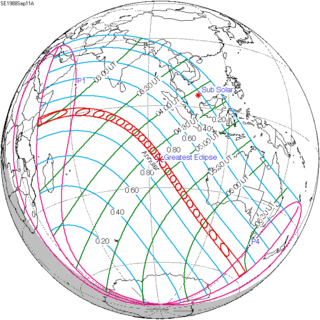| Solar eclipse of September 11, 1988 | |
|---|---|
| Type of eclipse | |
| Nature | Annular |
| Gamma | −0.4681 |
| Magnitude | 0.9377 |
| Maximum eclipse | |
| Duration | 417 s (6 min 57 s) |
| Coordinates | 20°00′S 94°24′E / 20°S 94.4°E |
| Max. width of band | 258 km (160 mi) |
| Times (UTC) | |
| Greatest eclipse | 4:44:29 |
| References | |
| Saros | 144 (15 of 70) |
| Catalog # (SE5000) | 9483 |
An annular solar eclipse occurred at the Moon's descending node of orbit on Sunday, September 11, 1988,[1] with a magnitude of 0.9377. A solar eclipse occurs when the Moon passes between Earth and the Sun, thereby totally or partly obscuring the image of the Sun for a viewer on Earth. An annular solar eclipse occurs when the Moon's apparent diameter is smaller than the Sun's, blocking most of the Sun's light and causing the Sun to look like an annulus (ring). An annular eclipse appears as a partial eclipse over a region of the Earth thousands of kilometres wide. Occurring only 12.5 hours after apogee (on September 10, 1988, at 16:10 UTC), the Moon's apparent diameter was smaller.[2]
Annularity was visible in southeastern Somalia (including the capital city Mogadishu), the Indian Ocean and Macquarie Island of Australia. A partial eclipse was visible for parts of East Africa, the Middle East, South Asia, Southeast Asia, Australia, and New Zealand.
- ^ "September 11, 1988 Annular Solar Eclipse". timeanddate. Retrieved 9 August 2024.
- ^ "Moon Distances for London, United Kingdom, England". timeanddate. Retrieved 9 August 2024.
